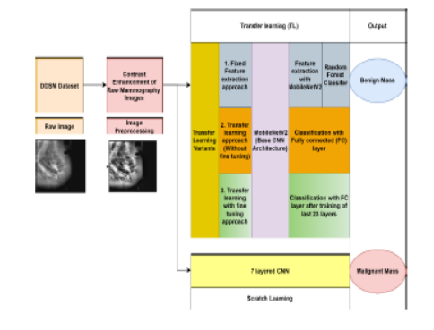


Indian Journal of Science and Technology
Year: 2023, Volume: 16, Issue: 18, Pages: 1385-1394
Original Article
Aarti Bokade1, Ankit Shah2*
1Research Scholar, Ph.D., Gujarat Technological University, Ahmedabad, 380005, Gujarat, India
2Assistant Professor, Instrumentation & Control Engineering Department, L.D.College of Engineering, Ahmedabad, 380015, Gujarat, India
*Corresponding Author
Email: [email protected]
Received Date:06 January 2023, Accepted Date:01 April 2023, Published Date:09 May 2023
Objectives: The study aims to utilize a Deep Convolutional Neural Network (Deep-CNN) model called MobileNetV2, which has low computational requirements, to accomplish binary classification of mammography images. To achieve this objective, the study investigates two methods: transfer learning and scratch learning. Methods: The proposed technique aims to classify mammography images from the Digital Database of Screening Mammography (DDSM) dataset into either malignant or benign categories using transfer learning and scratch learning methods based on Deep-CNN. Before being fed into the Deep-CNN, the images’ contrast level is enhanced using the min-max contrast enhancement technique. MobileNetV2, a lightweight CNN architecture, is used as a convolutional base with three transfer learning variants, including transfer learning without fine-tuning, transfer learning with fine-tuning, and fixed feature extraction, to achieve binary classification. The study also attempts to develop a seven-layered CNN architecture to accomplish mammography image classification through scratch learning. The trained breast cancer detection models’ classification performance, obtained through transfer and scratch learning methods, is evaluated based on machine learning performance metrics such as accuracy, precision, F1 Score, and area under the curve. Findings: The study conducted three transfer learning variants and found that combining MobileNetV2 with Random Forest classifier using the fixed feature extraction approach produced the best results, with an accuracy of 0.994 and a shorter training time of only 63.87 seconds compared to the other transfer learning variants. On the other hand, a seven-layer CNN model developed using scratch learning achieved a classification accuracy of 0.96, but it required a longer training period of 7980 seconds. Novelty: The breast cancer detection model introduced in this study exhibited superior performance compared to recently developed breast cancer detection models, as measured by accuracy and Area Under the Curve (AUC). The study found that the model created using the fixed feature extraction method showcases the effectiveness of utilizing MobilenetV2 and a Random Forest machine learning classifier in decreasing the number of trainable network parameters and network training time. Consequently, this presents an advantage for implementing the model on low-cost embedded platforms with limited memory size.
Keywords: Breast Cancer (BC); Computer Aided Detection (CAD); Deep Convolutional Neural Networks (DeepCNN); Transfer Learning (TL); Scratch Learning (SL)
© 2023 Bokade & Shah. This is an open-access article distributed under the terms of the Creative Commons Attribution License, which permits unrestricted use, distribution, and reproduction in any medium, provided the original author and source are credited. Published By Indian Society for Education and Environment (iSee)
Subscribe now for latest articles and news.